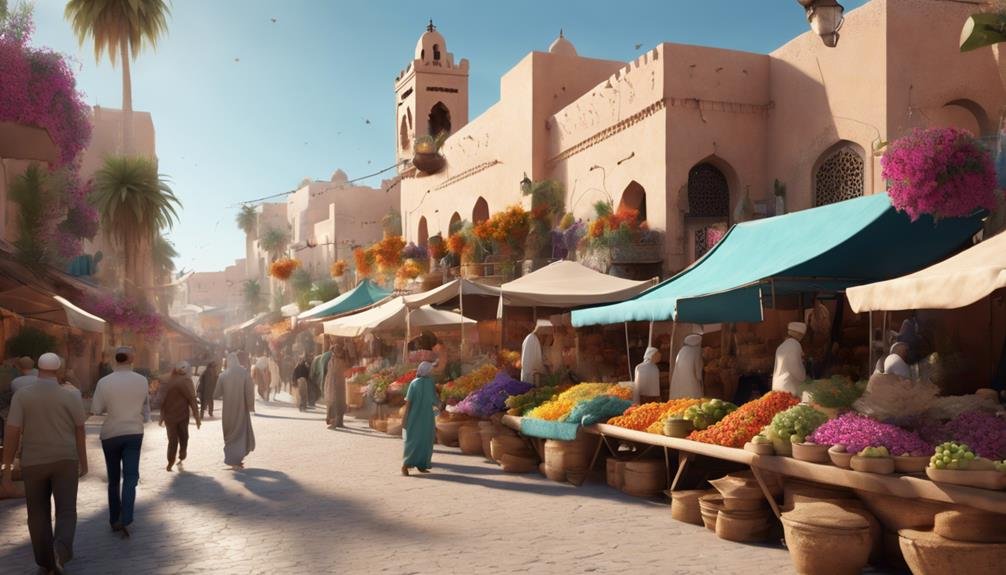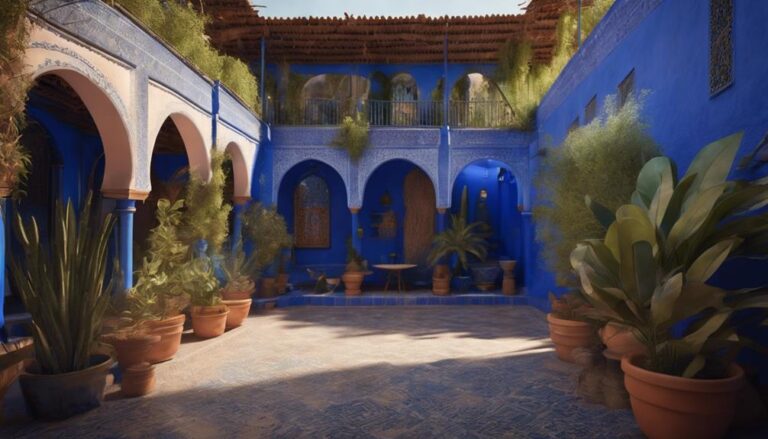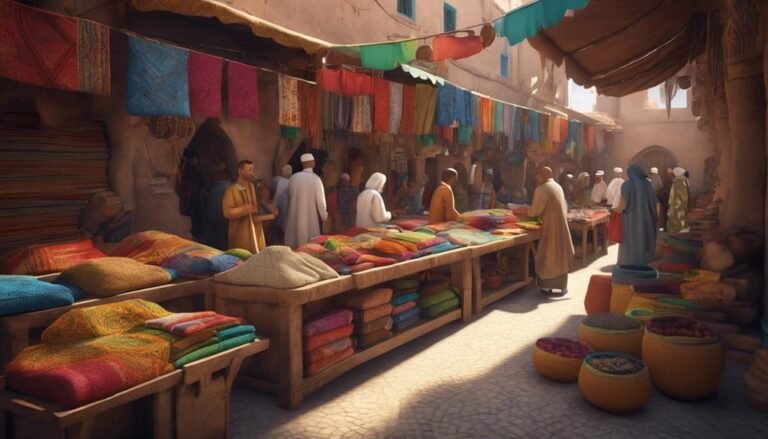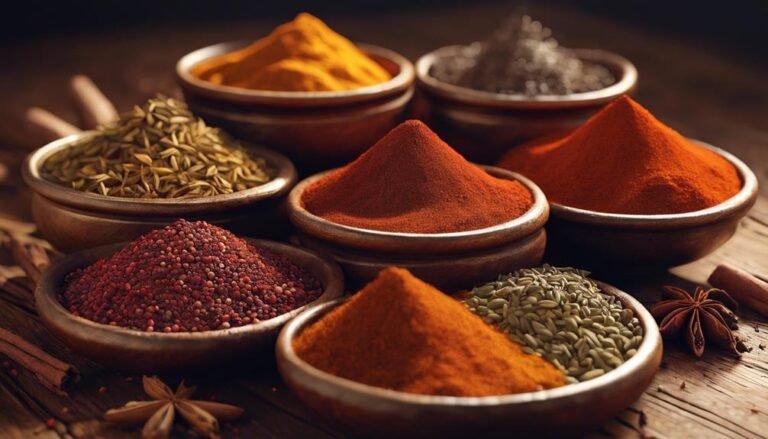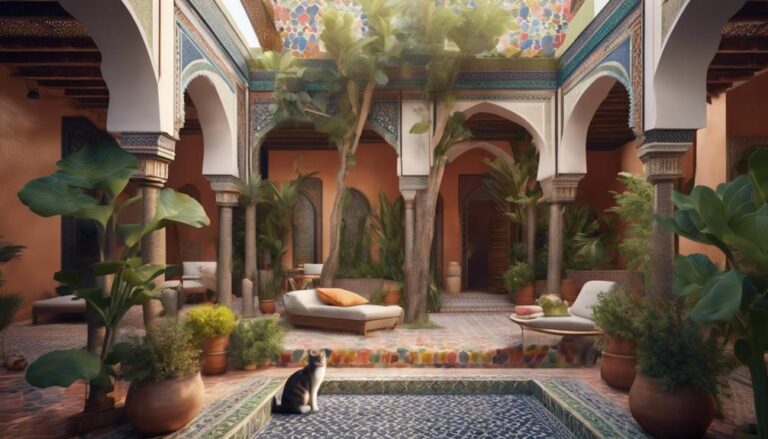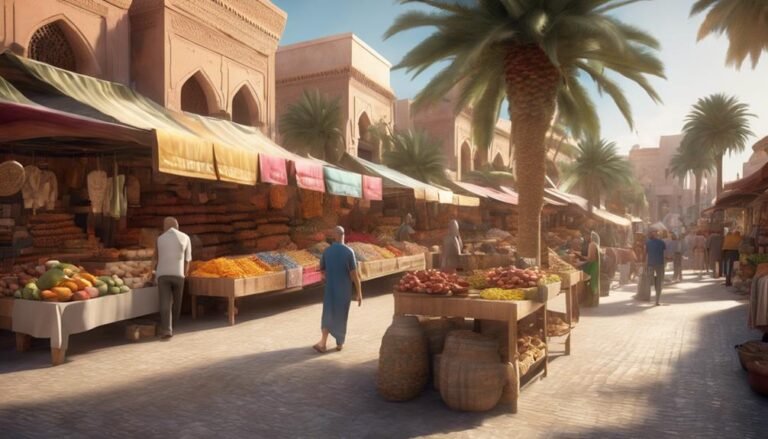For the best time to visit Morocco, aim for spring or fall. Spring, from March to May, showcases blooming landscapes and pleasant weather. In fall, from September to November, enjoy milder temperatures and fewer crowds. Summer, especially June to August, can get scorching inland. Winter, December to February, brings chilly weather and mountain snow. Each season offers unique experiences, from beach vacations in summer to skiing in winter. Consider cultural events too, like the Fes Festival of World Sacred Music in June. Discover more about Morocco's diverse seasons and activities to plan your ideal trip.
Key Takeaways
- Spring and fall offer pleasant weather and fewer crowds.
- Summer is hot, ideal for coastal visits.
- Winter is great for skiing in the mountains.
- Consider Ramadan for a unique cultural experience.
- Explore off-season for discounted prices and fewer tourists.
Climate Overview
When planning your trip to Morocco, understanding the climate overview is essential to make sure you pack appropriately and make the most of your visit. Morocco offers diverse landscapes and experiences, from desert excursions to beach getaways, mountain hikes to city escapes. The climate varies across the country, with coastal regions enjoying a Mediterranean climate characterized by mild, wet winters and hot, dry summers. In contrast, the interior regions, including Marrakech and the Sahara Desert, experience scorching summers and cool winters.
If you're seeking a beach retreat, the summer months from June to August are ideal for soaking up the sun along the Atlantic coast. For mountain hikes in the Atlas Mountains, spring and autumn offer pleasant temperatures and blooming landscapes. City escapes to destinations like Marrakech can be enjoyed year-round, but the shoulder seasons of spring and autumn provide milder weather for exploring the bustling souks and historic sites. Whether you prefer the beach, the mountains, or the city, Morocco's diverse climate ensures there's something for every type of traveler throughout the year.
Peak Tourist Seasons
Peak tourist seasons in Morocco typically see a surge in visitors flocking to popular destinations across the country. The peak times usually coincide with the summer months of June to August when the weather is hot and dry, making it ideal for exploring cities like Marrakech, Fes, and Casablanca. During these months, you can expect vibrant marketplaces, lively cultural events, and bustling streets filled with tourists from around the world.
However, it's important to be aware of travel restrictions that may impact your visit during peak tourist seasons. These restrictions could include limited availability of flights, crowded attractions, and higher accommodation prices. It's advisable to plan and book your trip well in advance to secure your travel arrangements and accommodations.
When visiting during peak tourist seasons, local accommodations tend to fill up quickly, so it's recommended to make reservations early. Many hotels, riads, and guesthouses offer unique experiences that showcase Moroccan hospitality, but availability can be limited during busy periods. By booking in advance, you can guarantee a comfortable stay and make the most of your visit to Morocco.
Shoulder Seasons
To avoid the crowds and higher prices associated with peak tourist seasons in Morocco, consider exploring the enchanting country during its shoulder seasons. Traveling during the shoulder seasons, which fall between the peak seasons, offers unique advantages for visitors.
One of the key travel advantages of visiting Morocco during the shoulder seasons is the quieter atmosphere. With fewer tourists around, you can enjoy a more peaceful and authentic experience, interacting with locals and immersing yourself in the culture without the hustle and bustle of peak times.
Moreover, the weather benefits during the shoulder seasons make it an ideal time to visit Morocco. In spring (April to June) and fall (September to November), the weather is generally pleasant, with milder temperatures compared to the extremes of summer and winter. This makes it comfortable for exploring the diverse landscapes, from the bustling markets of Marrakech to the serene beaches along the coast.
Embrace the charm of Morocco without the crowds and with favorable weather by planning your visit during the shoulder seasons.
Best Time for Sightseeing
For ideal sightseeing experiences in Morocco, consider planning your visit during the tranquil shoulder seasons. During these periods, which fall between the peak tourist times, you'll find the perfect balance of pleasant weather and fewer crowds, allowing you to explore the country's treasures at your own pace.
Morocco offers a rich tapestry of cultural experiences for sightseers. From the intricate architecture of the historic medinas to the vibrant souks filled with traditional crafts, every corner holds a piece of the country's diverse heritage waiting to be discovered. Immerse yourself in the local way of life by sampling the delicious Moroccan cuisine. Indulge in flavorful tagines, aromatic couscous, and invigorating mint tea as you wander through the bustling streets, taking in the sights, sounds, and scents of this enchanting destination.
Festival Highlights
Amidst Morocco's vibrant cultural tapestry, immerse yourself in the lively and colorful Festival Highlights that showcase the country's artistic talents and traditional celebrations. Morocco's rich heritage comes to life through a variety of cultural celebrations and local traditions that are highlighted during festivals held throughout the year.
From the famous Fes Festival of World Sacred Music to the lively Gnaoua World Music Festival in Essaouira, music festivals are a significant part of Morocco's cultural calendar. These events offer a unique opportunity to experience traditional and modern music styles, as well as dance performances that captivate audiences with their vibrant rhythms and colorful costumes.
In addition to music festivals, various other celebrations across the country provide insight into Morocco's diverse cultural landscape. From the Rose Festival in the Dades Valley to the Date Festival in Erfoud, each event offers a glimpse into the local way of life and the importance of age-old traditions. By attending these festivals, you not only get to enjoy the entertainment but also gain a deeper understanding of Morocco's rich cultural heritage.
Ideal Months for Outdoor Activities
Immerse yourself further in Morocco's diverse landscape by exploring the ideal months for outdoor activities, where you can experience the country's natural beauty in all its glory. When planning your adventure in Morocco, consider the following:
- Spring (March to May):
- Mild temperatures make it perfect for hiking in the Atlas Mountains.
- Witness blooming wildflowers and lush valleys.
- Autumn (September to November):
- Enjoy pleasant weather for desert treks in the Sahara.
- Experience the vibrant colors of fall foliage in the countryside.
- Summer (June to August):
- Coastal regions like Essaouira offer ideal conditions for water sports.
- Higher altitudes provide relief from the heat for activities like camping.
- Winter (December to February):
- Head to the south for milder winters, great for exploring oases and palm groves.
- Snow enthusiasts can hit the slopes in the High Atlas Mountains.
Consider these adventure opportunities and climate considerations when planning your outdoor escapades in Morocco.
Tips for Off-Season Travel
Discover valuable insights to enhance your off-season travel experience in Morocco. Traveling during the off-season can offer a unique perspective and a chance to immerse yourself in the local culture without the crowds. One significant advantage of off-season travel is the opportunity for budget travel. Accommodation prices tend to be lower, and you may find great deals on flights and tours. This can help you stretch your budget further and enjoy more experiences during your stay.
To truly immerse yourself in Moroccan culture during the off-season, consider staying in smaller, locally-run accommodations. This not only supports the local economy but also allows you to interact more closely with the community. Participating in cultural activities and festivals that are less crowded during this time can provide a more authentic experience.
Exploring Morocco off-season can also mean more personalized experiences. Tourist attractions are generally less crowded, giving you the chance to engage with locals and learn about their way of life. Embrace the quieter ambiance of the off-season and savor the charm of Morocco at your own pace.
Conclusion
So, the ideal time to visit Morocco is definitely during the magical months of spring and fall. The weather is perfect, the crowds are manageable, and the whole country comes alive with vibrant festivals and events.
Trust me, you won't regret experiencing the beauty and culture of Morocco during these peak seasons. It's truly a once-in-a-lifetime experience that you absolutely mustn't miss!

The Editorial Team is a passionate group of Morocco enthusiasts dedicated to sharing the beauty, culture, and wonders of this captivating country. With diverse backgrounds and a deep love for travel, we strive to bring you engaging and informative content that inspires your Moroccan adventures. From uncovering hidden gems and sharing local insights to exploring mouthwatering cuisine and showcasing the vibrant lifestyle, our team is committed to providing you with valuable resources and exciting stories that enhance your exploration of Morocco. Join us on this journey as we celebrate the rich heritage and unforgettable experiences that make Morocco truly special.

